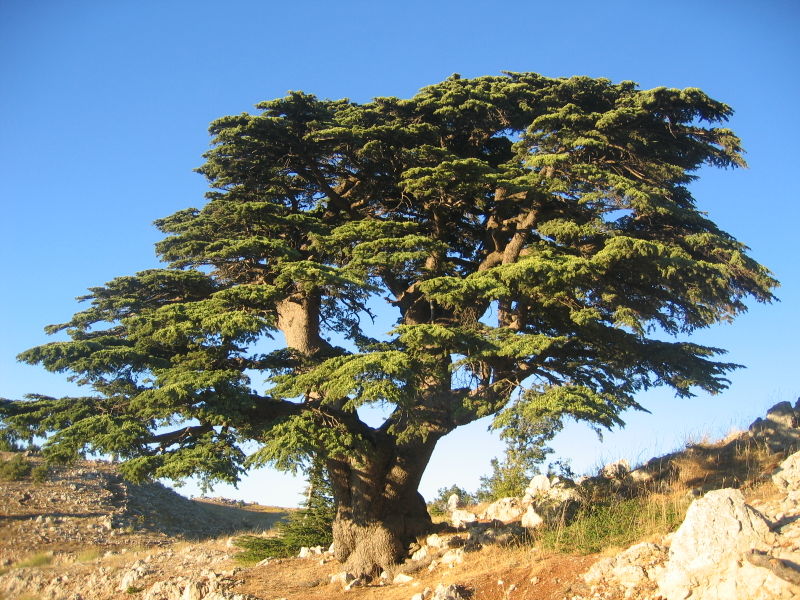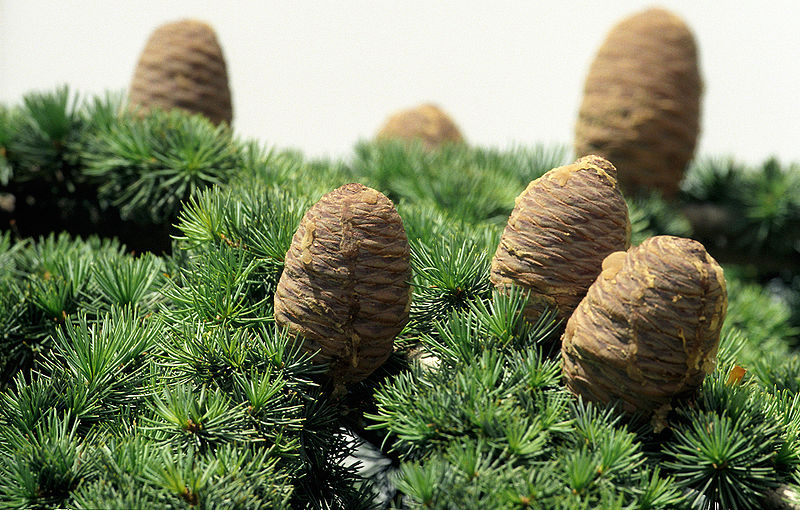 |
|
|
 |
| http://commons.wikimedia.org/wiki/User:Jerzystrzelecki |
Translate this page:
Summary
Physical Characteristics

 Cedrus atlantica is an evergreen Tree growing to 25 m (82ft) by 10 m (32ft) at a medium rate.
Cedrus atlantica is an evergreen Tree growing to 25 m (82ft) by 10 m (32ft) at a medium rate.
See above for USDA hardiness. It is hardy to UK zone 6. It is in leaf all year, in flower in September, and the seeds ripen from October to December. The species is monoecious (individual flowers are either male or female, but both sexes can be found on the same plant) and is pollinated by Wind.
Suitable for: light (sandy), medium (loamy) and heavy (clay) soils and prefers well-drained soil. Suitable pH: mildly acid, neutral and basic (mildly alkaline) soils and can grow in very alkaline soils.
It cannot grow in the shade. It prefers dry or moist soil and can tolerate drought. The plant can tolerates strong winds but not maritime exposure.
It can tolerate atmospheric pollution.
UK Hardiness Map
US Hardiness Map
Synonyms
C. atlantica. (Endlicher.)Manetti ex Carriére.
Habitats
Woodland Garden Canopy; Hedge;
Edible Uses
References More on Edible Uses
Medicinal Uses
Plants For A Future can not take any responsibility for any adverse effects from the use of plants. Always seek advice from a professional before using a plant medicinally.
Antidandruff Antifungal Antiseptic Nervine Pectoral Skin
An essential oil obtained from the distilled branches is a good antiseptic and fungicide that stimulates the circulatory and respiratory systems and also calms the nerves[238]. The oil is also astringent, diuretic, expectorant and sedative[254]. Diluted with a carrier oil such as almond, and massaged into the skin it is used in the treatment of skin diseases, ulcers, chest infections, catarrh, cystitis and dandruff[4, 238, 254]. It is used as an inhalant for treating bronchitis, tuberculosis and nervous tension[4, 238]. An infusion of the branches can also be used[238].
References More on Medicinal Uses
Now available: PLANTS FOR YOUR FOOD FOREST: 500 Plants for Temperate Food Forests and Permaculture Gardens.
An important new book from PFAF. It focuses on the attributes of plants suitable for food forests, what each can contribute to a food forest ecosystem, including carbon sequestration, and the kinds of foods they yield. The book suggests that community and small-scale food forests can provide a real alternative to intensive industrialised agriculture, and help to combat the many inter-related environmental crises that threaten the very future of life on Earth.
Read More
Other Uses
Essential Hedge Hedge Repellent Wood
An essential oil obtained from the distilled branches is used in perfumery, notably in jasmine-scented soaps[238]. The essential oil also repels insects[238]. Plants can be grown as a tall hedge[29]. Wood - fragrant and durable[238]. It is prized for joinery and veneer and is also used in construction[61, 238]. It is also used for making insect-repellent articles for storing textiles[238].
Special Uses
Food Forest Hedge Hedge Scented Plants
References More on Other Uses
Cultivation details
Thrives on most soils, being very tolerant of chalk, dry sites and of drought when it is established[11, 81, 200]. Prefers a rich loam or a sandy clay in full sun[1]. This species is more tolerant of atmospheric pollution than other members of the genus[11]. Succeeds in warm dry areas with less than 40cm of rain a year, but also in areas with cool summers and up to 200cm of rain[200]. Small trees less than 50cm tall establish much quicker and better than taller trees, those more than 2 metres tall are difficult to establish[200]. Larger trees will check badly and hardly put on any growth for several years. This also badly affects root development and wind resistance[200]. Trees grow fairly rapidly, with height gains of 60cm in a year recorded[185]. This species is cultivated for its timber in some parts of S. Europe[50]. Small male cones are formed on the lower branches of trees, whilst the larger female cones are formed on higher branches[238]. These female cones persist on the tree for 2 - 3 years before breaking up[238]. Trees are notably susceptible to honey fungus[200]. In garden design, as well as the above-ground architecture of a plant, root structure considerations help in choosing plants that work together for their optimal soil requirements including nutrients and water. The root pattern is fleshy. Thick or swollen - fibrous or tap root [2-1].
References Carbon Farming Information and Carbon Sequestration Information
Temperature Converter
Type a value in the Celsius field to convert the value to Fahrenheit:
Fahrenheit:
The PFAF Bookshop
Plants For A Future have a number of books available in paperback and digital form. Book titles include Edible Plants, Edible Perennials, Edible Trees, and Woodland Gardening. Our new book to be released soon is Edible Shrubs.
Shop Now
Propagation
Seed - collect the cones in winter and keep in a warm room until they open[1]. Sow immediately in a cold frame[78]. One report says that a short cold stratification of one month improves germination rates[113]. Keep the seed pot moist, but be careful because the young seedlings are very prone to damp off, keep them well ventilated[113]. Prick out the seedlings into individual pots when they are large enough to handle. Grow them on in a cold frame for their first winter and plant them out into their permanent positions in late spring or early summer. Give them some protection from winter cold for their first winter or two outdoors[K]. Cuttings of terminal shoots can be tried in a frame in November but they are very difficult[113].
Other Names
If available other names are mentioned here
Atlantic cedar
Native Plant Search
Search over 900 plants ideal for food forests and permaculture gardens. Filter to search native plants to your area. The plants selected are the plants in our book 'Plants For Your Food Forest: 500 Plants for Temperate Food Forests and Permaculture Gardens, as well as plants chosen for our forthcoming related books for Tropical/Hot Wet Climates and Mediterranean/Hot Dry Climates. Native Plant Search
Found In
Countries where the plant has been found are listed here if the information is available
Weed Potential
Right plant wrong place. We are currently updating this section.
Please note that a plant may be invasive in one area but may not in your area so it’s worth checking.
Conservation Status
IUCN Red List of Threatened Plants Status :

Growth: S = slow M = medium F = fast. Soil: L = light (sandy) M = medium H = heavy (clay). pH: A = acid N = neutral B = basic (alkaline). Shade: F = full shade S = semi-shade N = no shade. Moisture: D = dry M = Moist We = wet Wa = water.

Expert comment
Author
(Endl.)Carrière.
Botanical References
11200
Links / References
For a list of references used on this page please go here
Readers comment
| Add a comment |
|
If you have important information about this plant that may help other users please add a comment or link below. Only comments or links that are felt to be directly relevant to a plant will be included. If you think a comment/link or information contained on this page is inaccurate or misleading we would welcome your feedback at [email protected]. If you have questions about a plant please use the Forum on this website as we do not have the resources to answer questions ourselves.
* Please note: the comments by website users are not necessarily those held by PFAF and may give misleading or inaccurate information.
To leave a comment please Register or login here All comments need to be approved so will not appear immediately.
|
Subject : Cedrus atlantica
|
|
|
|